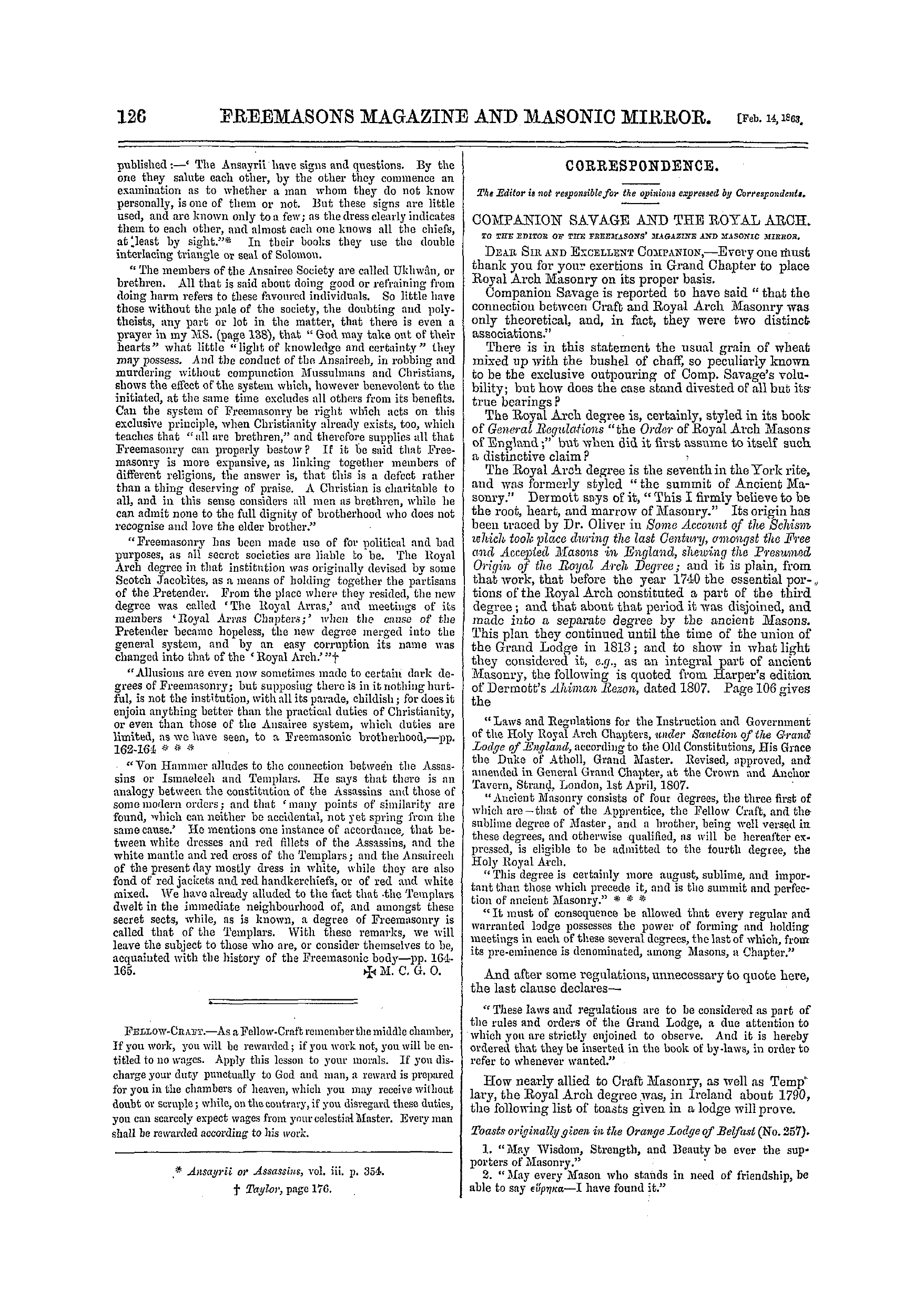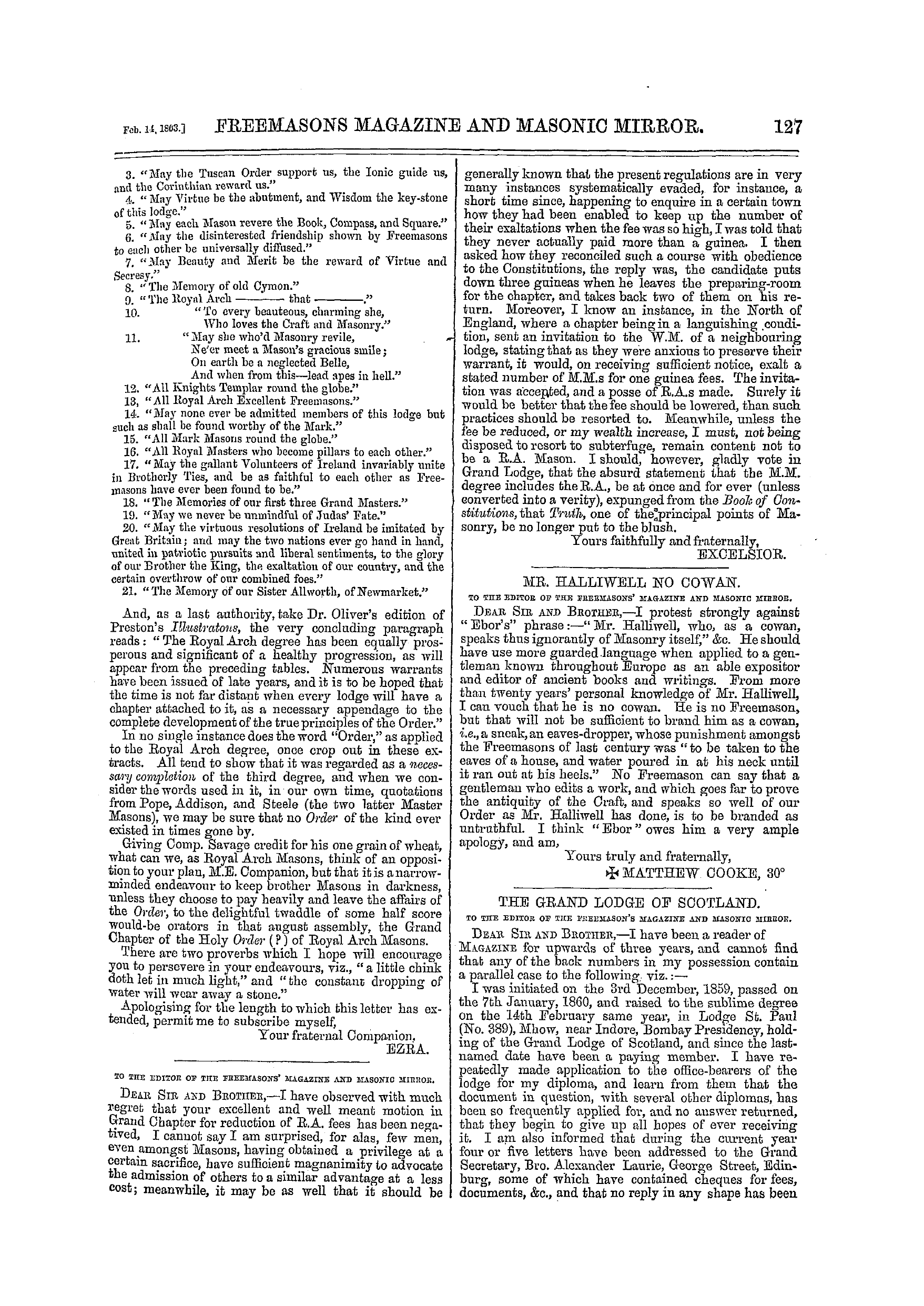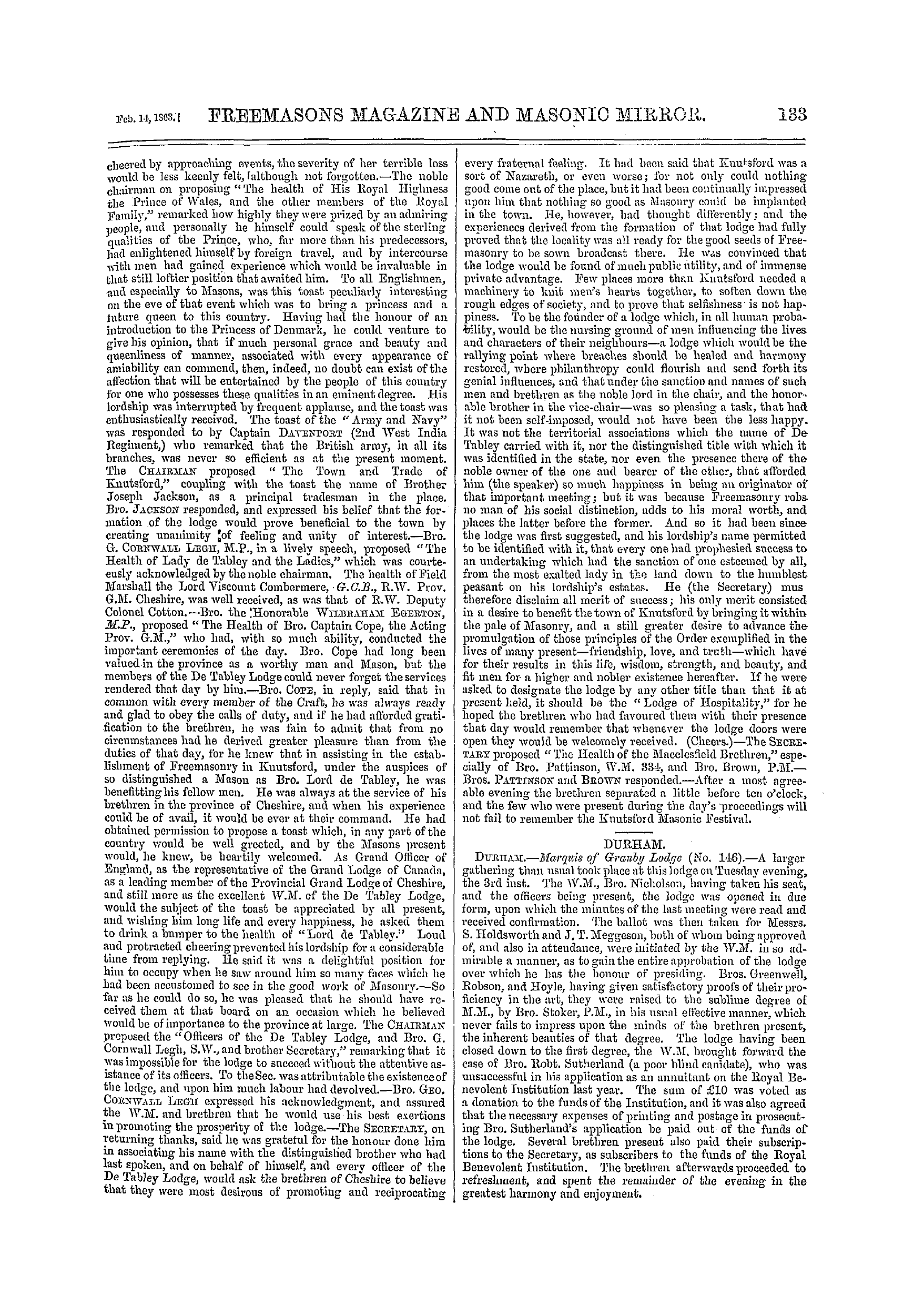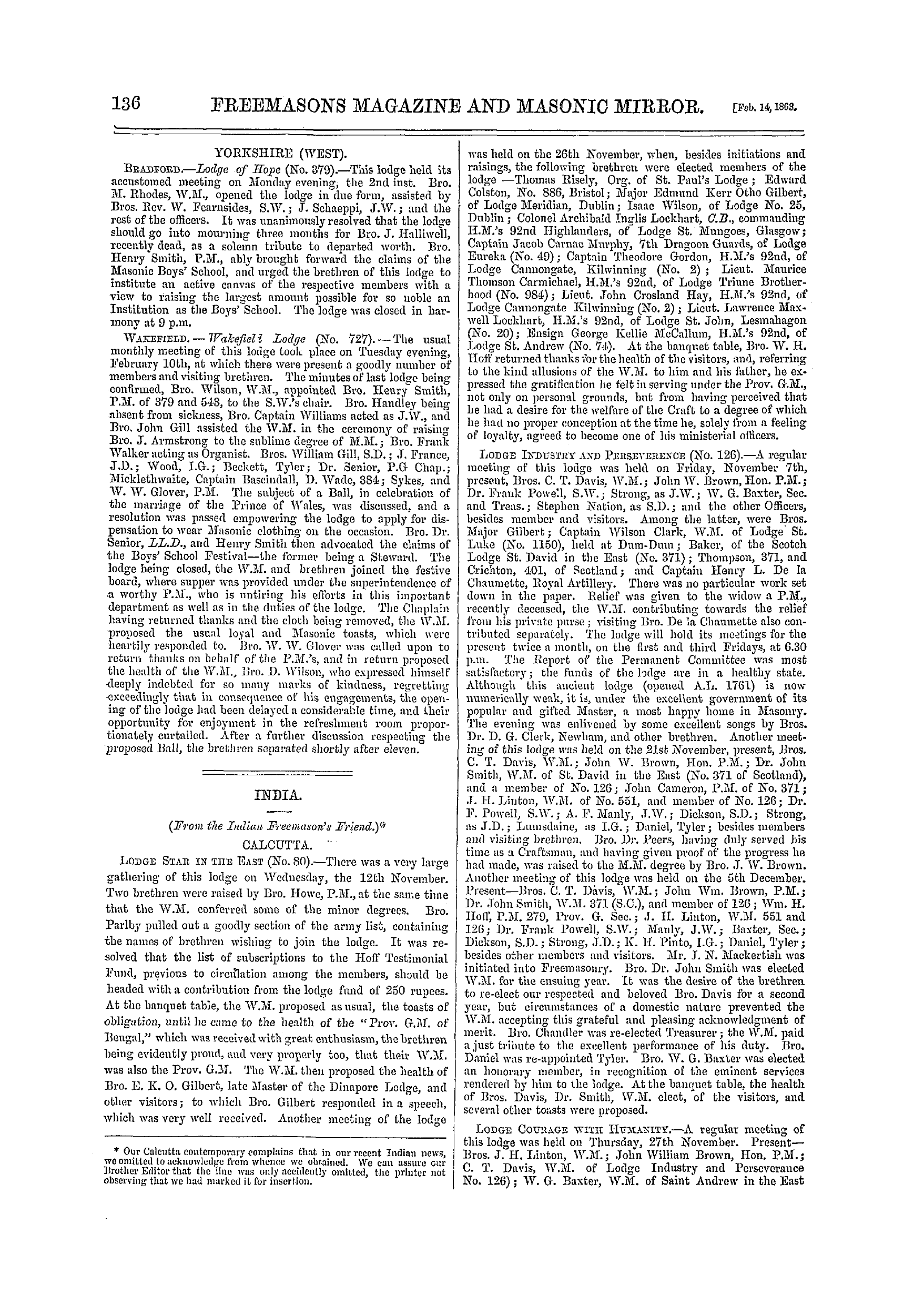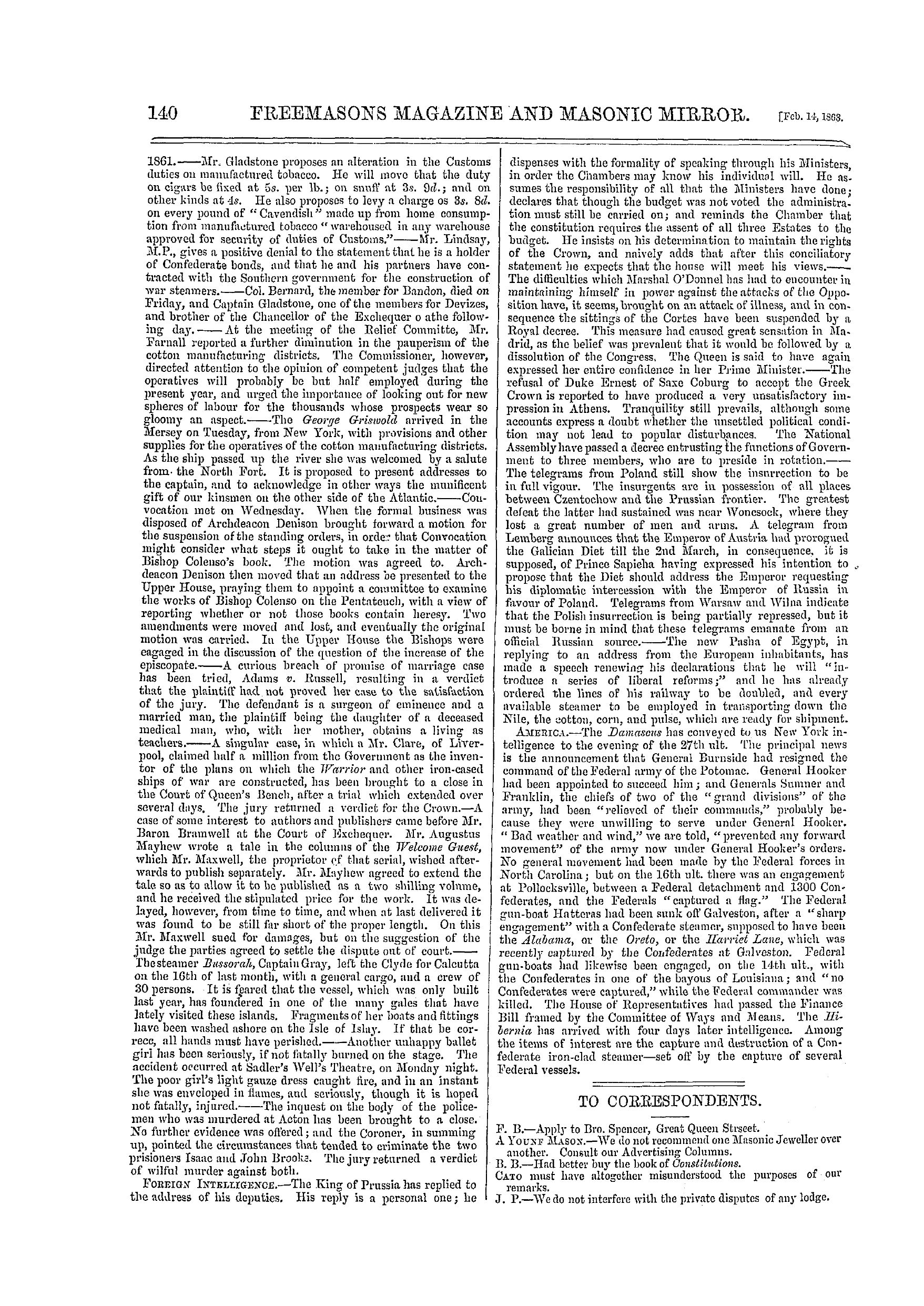-
Articles/Ads
Article ANTIQUITY OF MASONIC DEGREES. ← Page 2 of 2 Article WHAT HAS ST. JOHN THE DIVINE TO DO WITH ENGLISH MASONRY. Page 1 of 1 Article NATIONAL SONG FOR THE PRINCE OF WALES. Page 1 of 1
Note: This text has been automatically extracted via Optical Character Recognition (OCR) software.
Antiquity Of Masonic Degrees.
for the first time , styled the S . of the E . the Royal Arch , rejecting only such matter as might not accord with their vieAvs , and perhaps adding others . The old Arch , OB . as I have heard it given , was a military one . What possible grounds , then , can Ave have for claiming to represent the operative lodges and guilds ? I am
unaware of any . proof of the old London lodges having been operative , as the term is understood , though many of their members were undoubtedly such . So far from our traditions being swept away by such a theory , I believe it to be the only one which can establish them . Here , in the opinion of the promoters , were to be united the ceremonies and practices of . twor
distinct bodies , a speculative and an operative one , each originally having separate traditions and ceremonies , from which a third ensued , like the latter , though in a less degree , combining both , shameful preference being g iven to the ceremonies of the " moderns " at the union in 1813 . As a profession , a very small portion might claim , from the Freemasons ; as a mysteryin my
, humble opinion , entirely through the Templars . I am not the exponent of the Ancient and Accepted Rite ; it has plenty of able ones ; one thing is certain , the Rose Croix degree of that Rite , as given in the 15 th century on the Continent , is one and the same with Heredom of the Temple , stationed at York and elsewhere under its banner . Its more marked traces have been
gradually erased since 1851 , and an encampment stationed within 100 miles of " Ebor , " only abandoned them some two years ago at the complaint of members of a neighbouring Rose Croix Chapter . Others did so at once on the appearance of the new ritual , whilst generally , the Maltese ritual of the Athol Masons prevailed . Templary has never claimed to be the precursor of
Masonry , but it has claimed as the purpose of its institution , the preservation of Masonry in its pristine purity . It could not claim more than this , for we well know that the Masonic system was knoAvn in the East before 1118 , and we shall do well to follow our own traditions of its descent , in preference to the opinion of Von Hammer and other learned Orientalists .
By the bye , the author of the MS . edited by Bro . MattheAV Cooke , makes Speculative Masonry or the ceremonies of the ancient priests and geometricians , * of which he had a knowledge , as practised in the York monasteries , entirely distinct from those of the Operatives , who had not then commenced to trace their establishment from that city , as they did at a later period . I believe I am correct in stating that the first
mention of York in these constitutions , is about 1600 , my copy of 1500 being with a friend . It is quite possible that , as originally derived from Egypt , the ceremonies and constitutions of the operative builders , and those of the priestly geometricians , Avere much the same , but that the latter have been better preserved . We are informed by Masonic Avriters , that the Dionisian
Architectural mysteries , entitled their possessors to be present at the priestly mysteries . The later and the middle ages , ( under the Templars , ) do not afford the first proof of a connection between Speculative and Operative Masonry , they were intimately connected under the Maccabees , as Avell as under the Egyptian priests . I am very far from satisfied Avith "Ebor ' s "
explanation of the " unlaAvful" ceremonies cf the Templars , because in England , " the son of a Templar had peeped through the slits of the door into the chapter room , and seen a new member put to death (?) for hesitating to deny Christ . Long afterwards , being asked by his father to become a Templar , he refused ^ telling what he had seen : his father instantly slew him . " ( Secret Societies of the Middle Ages . ) I remain , dear Sir and Brother , ' yours fraternally , . A
What Has St. John The Divine To Do With English Masonry.
WHAT HAS ST . JOHN THE DIVINE TO DO WITH ENGLISH MASONRY .
TO TnE EDITOE OP TnE PEEEMASONS' MAGAZINE AND MASONIC MIEEOE . DEAR SIR AND BROTHER , —Appended to the report of the meeting of the Tower Hamlets Lodge ( No . 1204 ) , in your M AGAZINE of the 31 st of January last , is the following editorial note " What has St . John the Divine to do with English Masonry ?" I have no intention to occupy your columns with a lengthened essay upon this question , contenting myself
with the following extract from the FREEMASONS MAGAZINE for December , 1857 , which will fully satisfy the brethren of 1204 , answering your question too , if I mistake not , in your OAVU words : — " In no part of either Craft Masonry or the holy Royal Arch , as practised in England , is the name of St . John introduced , excepting that in some lodges , on the occasions of the
installations of the W . M ., it is mentioned that the annual election takes place as near the feast of St . John the Evangelist as possible . Prior to the uinon in 1813 , Ave believe most , if not all , lodges were dedicated to St . John the Evangelist , and the reason assigned for the above practice has been thus stated : — From the building of the first Temple to the Babylonish captivity , lodges were dedicated to King Solomon , after that time to Zerubbabel ; and after the destruction of the second . Temple by Titus , to John the Baptist . It is said that Masonry
was then on the decline for want of a Grand Master , and a deputation Avas sent to St . John the Evangelist , then residing at Ephesus , requesting him to accept the office . Although St . John Avas then above ninety years of age , he returned for answer , that as he had been initiated into the Order in early life and desired to see its extension , he Avould take upon himseif the office ; and from that time all Christian lodges were dedicated to him . This assumption is merely traditional , the more plausible theory ,
we think , is to be found in the customs of the annual installations of the W . M ., and festivals of all lodges , taking place at or near the summer or winter solstice ; the 21 st of June being the Festival of St . John the Baptist , the 21 st of December that of St . John the Evangelist . The Knights of St . John and the Templars , who still preserve the memory of St . John the Evangelist in their ceremonial , doubtless aided , if they did not oriinatethe use of the name of the ' beloved disciple' as the
g , , patron of the Order . " * * * * The above extract , I think , fully justifies your reporter in alluding to the Festival of St . John the Divine , or Evangelist ( which ever you please ) and also the refrain of the old Masonic ditty : — " St . John the Divine tells us wine , Cheers the body and soul . "
I am , dear Sir and Brother , yours fraternally , WM . WIGGINGTON , W . M . 1204 , P . Prov . G . Dir . of Cers , Worcestershire . [ The St . John ' s have not been acknowledged * in English Masonry , since the union of 1813 . — -ED . ]
National Song For The Prince Of Wales.
NATIONAL SONG FOR THE PRINCE OF WALES .
MUSIC AND WOEDS BAT GEOKGE LINLEY . Heav ' n crown his path with glory , And guide with mighty hand , The youthful Albert Edward , The Prince of our brave land . If kingly pow ' r await him Prom God , who reigns above ,
Oh ! may he rule his subjects With justice , truth , and love . Heav ' n crown his path , & c . His banner float the highest , On the forest of the sea , Before the throne of mercy , May he the humblest be .
A nation ' s prayers are rising To God , the King of all , If he be our foundation , The sceptre cannot fall . Heav ' n crown his path , & c .
Note: This text has been automatically extracted via Optical Character Recognition (OCR) software.
Antiquity Of Masonic Degrees.
for the first time , styled the S . of the E . the Royal Arch , rejecting only such matter as might not accord with their vieAvs , and perhaps adding others . The old Arch , OB . as I have heard it given , was a military one . What possible grounds , then , can Ave have for claiming to represent the operative lodges and guilds ? I am
unaware of any . proof of the old London lodges having been operative , as the term is understood , though many of their members were undoubtedly such . So far from our traditions being swept away by such a theory , I believe it to be the only one which can establish them . Here , in the opinion of the promoters , were to be united the ceremonies and practices of . twor
distinct bodies , a speculative and an operative one , each originally having separate traditions and ceremonies , from which a third ensued , like the latter , though in a less degree , combining both , shameful preference being g iven to the ceremonies of the " moderns " at the union in 1813 . As a profession , a very small portion might claim , from the Freemasons ; as a mysteryin my
, humble opinion , entirely through the Templars . I am not the exponent of the Ancient and Accepted Rite ; it has plenty of able ones ; one thing is certain , the Rose Croix degree of that Rite , as given in the 15 th century on the Continent , is one and the same with Heredom of the Temple , stationed at York and elsewhere under its banner . Its more marked traces have been
gradually erased since 1851 , and an encampment stationed within 100 miles of " Ebor , " only abandoned them some two years ago at the complaint of members of a neighbouring Rose Croix Chapter . Others did so at once on the appearance of the new ritual , whilst generally , the Maltese ritual of the Athol Masons prevailed . Templary has never claimed to be the precursor of
Masonry , but it has claimed as the purpose of its institution , the preservation of Masonry in its pristine purity . It could not claim more than this , for we well know that the Masonic system was knoAvn in the East before 1118 , and we shall do well to follow our own traditions of its descent , in preference to the opinion of Von Hammer and other learned Orientalists .
By the bye , the author of the MS . edited by Bro . MattheAV Cooke , makes Speculative Masonry or the ceremonies of the ancient priests and geometricians , * of which he had a knowledge , as practised in the York monasteries , entirely distinct from those of the Operatives , who had not then commenced to trace their establishment from that city , as they did at a later period . I believe I am correct in stating that the first
mention of York in these constitutions , is about 1600 , my copy of 1500 being with a friend . It is quite possible that , as originally derived from Egypt , the ceremonies and constitutions of the operative builders , and those of the priestly geometricians , Avere much the same , but that the latter have been better preserved . We are informed by Masonic Avriters , that the Dionisian
Architectural mysteries , entitled their possessors to be present at the priestly mysteries . The later and the middle ages , ( under the Templars , ) do not afford the first proof of a connection between Speculative and Operative Masonry , they were intimately connected under the Maccabees , as Avell as under the Egyptian priests . I am very far from satisfied Avith "Ebor ' s "
explanation of the " unlaAvful" ceremonies cf the Templars , because in England , " the son of a Templar had peeped through the slits of the door into the chapter room , and seen a new member put to death (?) for hesitating to deny Christ . Long afterwards , being asked by his father to become a Templar , he refused ^ telling what he had seen : his father instantly slew him . " ( Secret Societies of the Middle Ages . ) I remain , dear Sir and Brother , ' yours fraternally , . A
What Has St. John The Divine To Do With English Masonry.
WHAT HAS ST . JOHN THE DIVINE TO DO WITH ENGLISH MASONRY .
TO TnE EDITOE OP TnE PEEEMASONS' MAGAZINE AND MASONIC MIEEOE . DEAR SIR AND BROTHER , —Appended to the report of the meeting of the Tower Hamlets Lodge ( No . 1204 ) , in your M AGAZINE of the 31 st of January last , is the following editorial note " What has St . John the Divine to do with English Masonry ?" I have no intention to occupy your columns with a lengthened essay upon this question , contenting myself
with the following extract from the FREEMASONS MAGAZINE for December , 1857 , which will fully satisfy the brethren of 1204 , answering your question too , if I mistake not , in your OAVU words : — " In no part of either Craft Masonry or the holy Royal Arch , as practised in England , is the name of St . John introduced , excepting that in some lodges , on the occasions of the
installations of the W . M ., it is mentioned that the annual election takes place as near the feast of St . John the Evangelist as possible . Prior to the uinon in 1813 , Ave believe most , if not all , lodges were dedicated to St . John the Evangelist , and the reason assigned for the above practice has been thus stated : — From the building of the first Temple to the Babylonish captivity , lodges were dedicated to King Solomon , after that time to Zerubbabel ; and after the destruction of the second . Temple by Titus , to John the Baptist . It is said that Masonry
was then on the decline for want of a Grand Master , and a deputation Avas sent to St . John the Evangelist , then residing at Ephesus , requesting him to accept the office . Although St . John Avas then above ninety years of age , he returned for answer , that as he had been initiated into the Order in early life and desired to see its extension , he Avould take upon himseif the office ; and from that time all Christian lodges were dedicated to him . This assumption is merely traditional , the more plausible theory ,
we think , is to be found in the customs of the annual installations of the W . M ., and festivals of all lodges , taking place at or near the summer or winter solstice ; the 21 st of June being the Festival of St . John the Baptist , the 21 st of December that of St . John the Evangelist . The Knights of St . John and the Templars , who still preserve the memory of St . John the Evangelist in their ceremonial , doubtless aided , if they did not oriinatethe use of the name of the ' beloved disciple' as the
g , , patron of the Order . " * * * * The above extract , I think , fully justifies your reporter in alluding to the Festival of St . John the Divine , or Evangelist ( which ever you please ) and also the refrain of the old Masonic ditty : — " St . John the Divine tells us wine , Cheers the body and soul . "
I am , dear Sir and Brother , yours fraternally , WM . WIGGINGTON , W . M . 1204 , P . Prov . G . Dir . of Cers , Worcestershire . [ The St . John ' s have not been acknowledged * in English Masonry , since the union of 1813 . — -ED . ]
National Song For The Prince Of Wales.
NATIONAL SONG FOR THE PRINCE OF WALES .
MUSIC AND WOEDS BAT GEOKGE LINLEY . Heav ' n crown his path with glory , And guide with mighty hand , The youthful Albert Edward , The Prince of our brave land . If kingly pow ' r await him Prom God , who reigns above ,
Oh ! may he rule his subjects With justice , truth , and love . Heav ' n crown his path , & c . His banner float the highest , On the forest of the sea , Before the throne of mercy , May he the humblest be .
A nation ' s prayers are rising To God , the King of all , If he be our foundation , The sceptre cannot fall . Heav ' n crown his path , & c .







